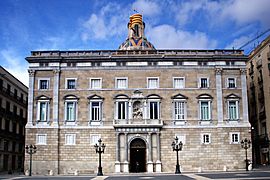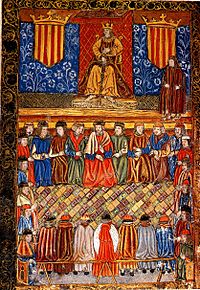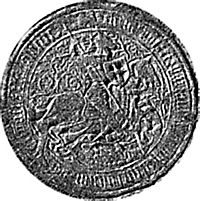Catalan Courts facts for kids
Quick facts for kids General Court of CataloniaCort General de Catalunya (Catalan) |
|
|---|---|
| Principality of Catalonia | |
| Type | |
| Type |
Tricameral
|
| Houses | Braços: Ecclesiastical estate Military estate Royal estate |
| History | |
| Established | 1214/1218 |
| Disbanded | 1714 |
| Preceded by | Comital Court Peace and Truce Assemblies |
| Succeeded by | Courts of Castile |
| Leadership | |
|
Count of Barcelona
|
|
| Seats | 5501 |
| Elections | |
|
Military estate voting system
|
Ennoblement or inheritance |
|
Royal estate voting system
|
Indirect election by local assemblies |
| Meeting place | |
 |
|
| Itinerant, different places of Catalonia. The Palau de la Generalitat was the place where the last Courts (1705–1706) met | |
| Footnotes | |
| 1Reflecting composition of the Courts of 1705–1706
See also: Parliament of Catalonia |
|
The Catalan Courts or General Court of Catalonia (Catalan: Corts Catalanes or Cort General de Catalunya) was an important law-making body in Catalonia. It worked like a parliament from the 1200s to the 1700s.
This group included the king and three main social groups. Many historians see it as an excellent example of a medieval parliament. It was even more organized than the parliaments in England or France at the time. Unlike some other courts, the Catalan Courts made real laws. The king could not change these laws on his own. It was similar to the Parliament of England and other law-making bodies in Europe.
The General Courts of the Crown of Aragon were big meetings. They brought together the Courts of Aragon, Valencia, and Catalonia. People from Majorca also sent their representatives. These meetings often happened in towns like Monzón or Fraga. These towns were good meeting spots because they were between Zaragoza and Barcelona.
The Catalan Courts met for nearly 500 years. They stopped meeting in 1716 because of new laws called the Nueva Planta decrees. Catalonia only got a new legislative assembly in 1932.
Contents
How the Courts Worked: Members and Laws
The Courts were made up of three main groups, called braços in Catalan. These groups represented the different parts of society:
- The military group (Braç Militar) included nobles and knights.
- The church group (Braç Eclesiàstic) had leaders from the church.
- The royal group (Braç Reial) had representatives from cities and towns.
The Archbishop of Tarragona usually led the church group. This group included bishops, abbots, and other church leaders.
The king, as the count of Barcelona, called the Courts together. He also led their meetings. The king would start with a speech. Then, the three groups would work on making laws. The king always had to agree with these laws.
- Laws that came from the king were called "Constitutions" (Constitucions).
- Laws that came from the three groups were called "Court Chapters" (Capítols de Cort).
- Sometimes, the king made a law by himself. These were called "Acts of Court" (Actes de Cort). But these laws needed the Courts to approve them later.
History of the Catalan Courts
Early Beginnings

The Catalan Courts started from an older group called the Comital Court of Barcelona around the year 1000. They also followed the tradition of "Peace and Truce" meetings. These meetings began in 1021 to stop wars and fighting between nobles. In 1192, people from towns joined these meetings for the first time. The first set of Catalan laws, the Usages of Barcelona, came from these early meetings.
The rulers of Barcelona, the counts, did not have much money or military power. This was especially true during tough economic times or when they wanted to expand their lands. So, they needed help from others. This need led to the Comital Court growing bigger. After Barcelona joined with the Kingdom of Aragon in 1164, it became the Royal Court.
The Royal Court meeting in 1214 was very important. It was called to help Catalonia after King Peter of Aragon died in battle. His son, James I, was only six years old. The new king took an oath in front of church leaders, nobles, and town representatives. The meeting in 1218 is seen as the first true General Court. This is because it included representatives from the towns and discussed many different issues.
Courts with Clear Rules
Under King Peter the Great (1276–1285), the Catalan Courts became more organized.
The Courts of 1283
In 1283, the king agreed to hold a General Court every year. This was to discuss the good of the land and make new rules. The king promised that he would need the approval of the church leaders, nobles, knights, and citizens to make any new general laws in Catalonia. This was a big change. It meant the Catalan Courts officially became a law-making body. The king could not pass laws without their agreement.
The Courts of 1289
In 1289, a special group was chosen from the General Court. This group became a permanent council. Their job was to collect money that the groups agreed to give the king. Later, in the 1300s, this group became the Deputation of the General, also known as the Generalitat. This idea was also used to create the Valencian Generalitat in the 1400s.
The Courts of 1358
In 1358–1359, the Courts met under King Peter IV. At this time, Castile had attacked Aragon and Valencia. This caused many wars and cost a lot of money. Because of this, the Courts chose twelve deputies. These deputies had the power to handle taxes. They also chose "auditors of accounts" (oïdors de comptes). These auditors checked how money was being spent. This is how the Deputation of the General, or "Generalitat," was truly formed. Berenguer de Cruïlles, a bishop, is seen as its first president.
The Courts of 1480
These Courts were the first under King Ferdinand II the Catholic. They helped fix many problems left over from the Catalan Civil War (1462–1472). They decided on the role of the Deputation of the General and how to return properties. They also agreed that both sides in the war shared the blame. The focus was on rebuilding the country, not punishing those who lost.
A very important rule was approved here, called "Poc valdría." Later, it was known as the "Constitution of the Observance." This rule said that the king had to follow and respect the laws of Catalonia. It also told the Deputation of the General to make sure the king and his officers followed these laws. If an order from the king was against the laws, the Deputation could cancel it. This rule was a key part of how Catalonia kept its special agreements with the king.
Modern History: Changes and End
The Habsburg Rulers
In 1519, the Courts met in Barcelona to recognize Charles I as the new ruler. He was the first king to unite the crowns of Castile and Aragon. The Courts also discussed giving money to the king. While he was in Barcelona, Charles learned he had been chosen as the Holy Roman Emperor.
During the time of the Habsburg kings, the Catalan Courts met less often. This was because the kings wanted more absolute power. So, the Generalitat, which made sure Catalonia's laws were followed, became more important. To get advice and discuss problems, the Generalitat often called the Junta de Braços. This was a meeting of members of the Catalan Courts who were in Barcelona.
Under King Philip IV (1621–1665), there were many disagreements between Catalonia and the king. In 1626, the king tried to pass a plan called the "Union of Arms." This plan asked every part of Spain to contribute soldiers. But the Catalan groups opposed this because it went against their laws. These disagreements, along with other problems, led to the Reapers' War (1640–1652).
The Last Courts and Their End
The very last General Court was led by King Charles III. It met in Barcelona in 1705–1706. This meeting brought important new rules to protect people's rights. For example, it made sure that letters could not be secretly read. It also made stronger the "Court of Contraventions" (Tribunal de Contrafaccions). This court was created to make sure all laws were followed. It could even stop actions by the king or his officers if they went against Catalan law.
The Catalan Courts, along with most other Catalan institutions and laws, were ended after the War of Spanish Succession in 1714. The new Spanish king, Philip V, issued the Nueva Planta decrees in 1716. These decrees created a system of government like the French one, where the king had absolute power. From then on, representatives from Catalonia, Aragon, and Valencia joined the Courts of Castile. However, these Courts mostly just advised the king.
Today, the Parliament of Catalonia was created in 1932. It is seen as the modern-day successor to the historic Catalan Courts.
See also
- Parliament of Catalonia
- Junta de Braços
- Generalitat of Catalonia
- Cortes Generales
- History of democracy
 In Spanish: Cortes Catalanas para niños
In Spanish: Cortes Catalanas para niños


